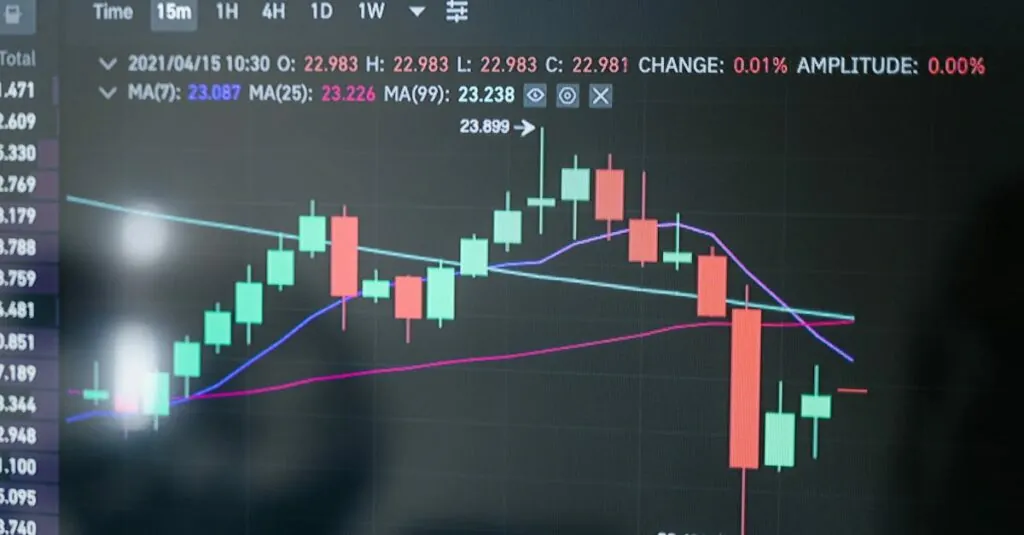Table of Contents
ToggleWhen the stock market takes a nosedive, it’s not just wallets that feel the impact; emotions run high and creativity often takes a backseat. But what if there was a way to channel that anxiety into something productive—and even a bit hilarious? Enter the world of stock market crash drawing. This artistic outlet isn’t just about doodling sad graphs; it’s a cathartic way to laugh in the face of financial chaos.
Imagine turning those panic-stricken moments into whimsical illustrations that capture the absurdity of market fluctuations. From cartoon bulls and bears to exaggerated stock prices, there’s no limit to the creativity that can arise from a downturn. So grab your sketchpad and let’s explore how drawing can transform the chaos of a stock market crash into a canvas of humor and insight.
Overview of Stock Market Crashes
Stock market crashes represent significant declines in equity prices during a short period. Such events often create turmoil in financial markets, resulting in widespread fear and uncertainty among investors. Historical examples of notable crashes include the Great Depression of 1929 and the 2008 financial crisis.
Investors typically react to sudden downturns with panic, which fuels further selling. Factors contributing to crashes often involve economic imbalances, overvalued assets, and external shocks. These elements create an unstable environment prone to rapid decline.
In the aftermath of a crash, recovery varies. On average, markets take years to return to pre-crash levels. Investors may witness increased volatility during this recovery phase, influencing their long-term strategies.
Analysts often use indicators such as the Price-to-Earnings ratio and market sentiment to assess the likelihood of a crash. Attention to these metrics can help identify overvalued or undervalued stocks. Understanding market cycles also plays a critical role in anticipating potential downturns.
Drawing as a creative response to stock market crashes allows individuals to process their emotional reactions. By illustrating whimsical depictions of market absurdities, one can find catharsis amid financial chaos. This artistic outlet often leads to deeper insights about market dynamics and personal finance.
Seeking patterns in historical data may also aid investors in making informed decisions. Historical patterns reveal that markets face cycles of growth and contraction. By analyzing past behavior, investors can better prepare for future downturns and develop resilience against emotional turmoil.
Importance of Stock Market Crash Drawing
Stock market crash drawing offers a unique way to confront the emotional challenges posed by financial downturns. By creatively illustrating market absurdities, individuals gain a fresh perspective on their experiences.
Historical Context
Stock market crashes, such as the Great Depression of 1929 and the 2008 financial crisis, provide significant lessons. These events reveal patterns in market behavior and investor responses. Drawing from these historical contexts can illuminate insights into current market dynamics. Artists and investors can reflect on the chaos and unpredictability of these downturns through their artistic expressions. Emotional responses become tangible through sketches that capture the absurdity of volatile markets. Understanding past crashes equips individuals to better interpret future scenarios.
Psychological Impact
The psychological toll of market crashes often manifests as anxiety and fear. Many individuals feel overwhelmed when faced with sudden financial losses. Drawing becomes an outlet for processing these emotions. Sketching allows individuals to externalize their stress, transforming panic into humor or reflection. It fosters a sense of control amid uncertainty. Engaging in this creative process can provide clarity and promote resilience. Additionally, it encourages investors to confront their fears and strengthen their emotional intelligence, enhancing decision-making during turbulent times.
Key Elements of a Stock Market Crash Drawing
Stock market crash drawings utilize specific techniques and symbols to capture the emotional landscape of financial turmoil. These elements transform anxiety into creative expression.
Visual Techniques
Artists employ various visual techniques to depict market chaos. Bright colors often contrast dark themes, highlighting extreme emotions. Bold lines convey movement, suggesting volatility in stock prices. Distorted proportions represent the unpredictability of market behavior. Incorporating humor through exaggerated features allows viewers to engage with anxiety in a light-hearted way. These techniques help simplify complex emotions, making them accessible and relatable.
Symbolic Representations
Symbolism plays a pivotal role in stock market crash drawings. Common symbols include bears, representing market declines, and bulls, indicating optimistic trends. The use of clocks and hourglasses signifies time pressure during crashes. Additionally, images of falling coins illustrate financial loss. Such symbols evoke immediate emotions and encourage reflection on investor behavior. These representations capture the essence of market fluctuations while fostering dialogue on emotional responses.
Famous Stock Market Crash Drawings
Numerous artists have expressed the chaos of stock market crashes through unique drawings. Illustrations often feature exaggerated scenarios that depict the fears and reactions of investors, each capturing a different facet of market turmoil.
One notable example is John S. Pughe’s 1929 cartoon titled “The New Deal,” which humorously criticizes government responses to the Great Depression. Pughe used caricatures to symbolize despair, showcasing the panic that gripped the nation. This drawing served not only as commentary but also as an emotional release for those affected by the crash.
Another famed illustration comes from the aftermath of the 2008 financial crisis. Several artists produced works highlighting the absurdity of banker bonuses amid widespread economic hardship. This was depicted through satirical visuals that combined humor and criticism, encouraging reflection on the disparities during financial downturns.
Visual symbols often appear throughout these artworks. Bears, representing falling markets, and bulls, symbolizing rising markets, convey the volatility investors face. The recurring use of clocks reflects the urgency and time sensitivity associated with market decisions, amplifying anxiety felt during crashes.
Innovative techniques like contrasting colors enhance the emotional impact of these drawings. Bright hues against darker themes capture attention and evoke a deeper response from viewers. Emotionally charged illustrations help create dialogue around financial crises, transforming feelings of panic into relatable humor.
Through these various artworks, artists make sense of the chaos, allowing viewers to confront their emotions regarding market fluctuations. By engaging with these drawings, individuals can connect with the broader experience of financial turmoil while gaining insights into their own reactions.
Stock market crash drawing offers a unique way to navigate the emotional landscape of financial turbulence. By transforming anxiety into art, individuals can gain insights and foster resilience during chaotic times. This creative outlet not only captures the absurdity of market fluctuations but also encourages reflection on personal responses to financial crises.
Engaging with this artistic process allows for a deeper understanding of market dynamics while promoting emotional intelligence. As investors face future downturns, embracing stock market crash drawing can be a powerful tool for processing feelings and making informed decisions. Ultimately, it highlights the importance of creativity in confronting the challenges posed by financial instability.




